What is the “sluggish growth type” that accounts for approximately forty percent of middle-aged and senior workers? Characteristics of the progress-stagnant group that is common among people in their early fifties
Release Date: Update Date:
※This article is a machine translation.
In our previous report, “The five behavioral traits that are common among middle-aged and senior workers who are making progress,” we looked at the five behavioral characteristics that encourage people to make strides: “making work meaningful,” “trying things out first,” “making use of what you have learned,” “getting involved with other people on your own,” and “getting along well with younger people.” So, what percentage of middle-aged and senior workers actually demonstrate these five behavioral characteristics? And what are the characteristics of middle-aged and senior workers who are struggling to make progress and are unable to play an active role as they would like?
In this report, we will conduct cluster analysis based on the five behavioral characteristics we reported on last time, and take a closer look at the personalities of middle-aged and senior workers divided into five types (see below for an overview of the survey).

- The “stagnant type” accounts for about 40% of the total
- The real picture of the “stagnant type”
- Summary: Behavioral changes in the ‘stagnant type’ are the key to solving management issues
1. The “stagnant type” accounts for about 40% of the total
As a result of cluster analysis (non-hierarchical clustering, k-means method) using the “5 Behavioral Characteristics” index, we found that there were five different types of human resources. Based on the characteristics of each type of human resource, we decided to name them the “High Performer Type”, “Balanced Type”, “Stagnant Type”, “Quiet Type” and “Inactive Type”.
Below, we will introduce the characteristics of each type. The broken lines on the radar charts for each type indicate the average values.
【High-Performer Type】
A group that is implementing all five breakthrough actions at a level that greatly exceeds the average.
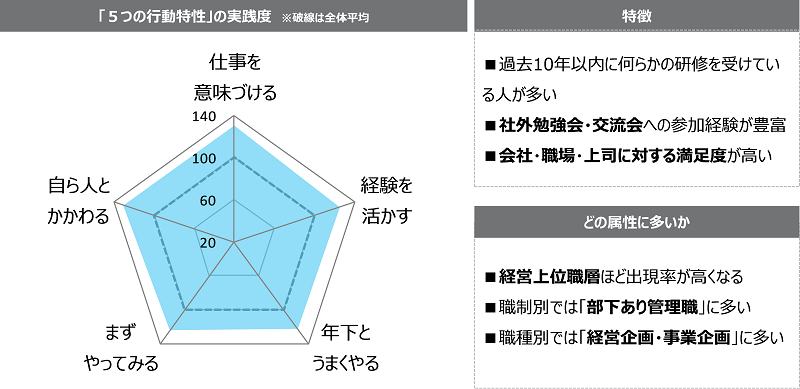
【Balanced Type】
A group that is implementing all five breakthrough actions at a level that is slightly above the average.
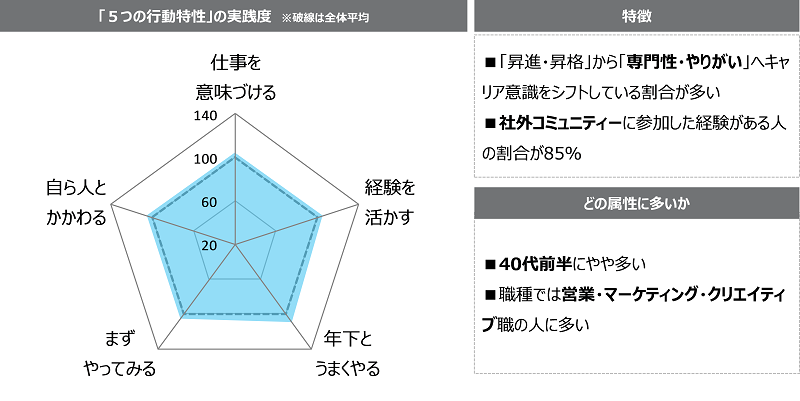
【Stagnant type】
The “stagnant” group, who are performing all of the breakthrough actions at a level slightly below the average.
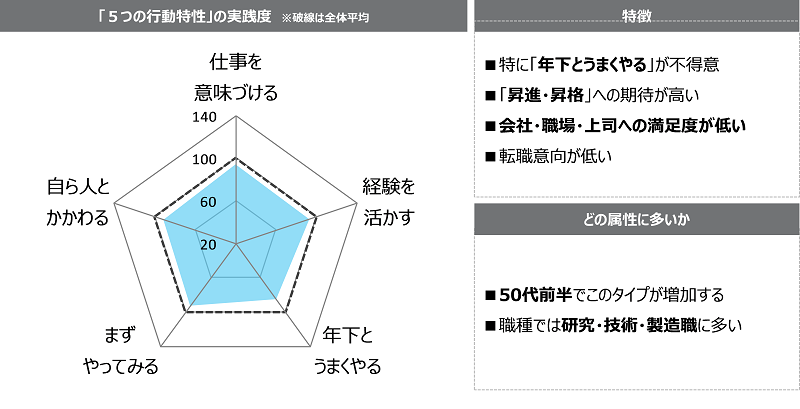
【Status quo/comfortable type】
The “status quo” group, who have good relationships with younger members but are not performing any of the other breakthrough actions.
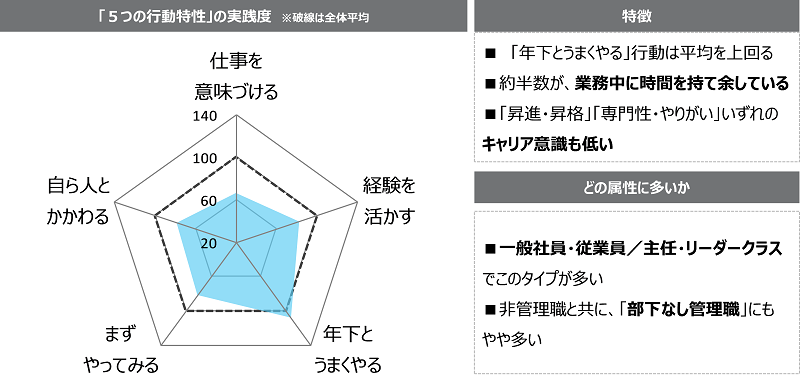
【Inactive type】
The “inactive” group, who are performing all of the breakthrough actions at a level significantly below the average.

The percentages of the five types of human resources are as follows.
[Figure] Percentage of the five types of human resources
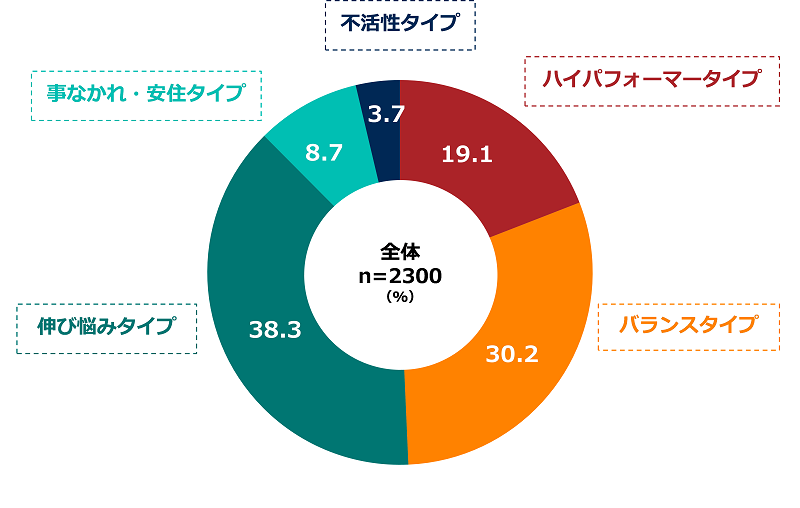
The results of the survey showed that there are approximately 20% of high performers who are implementing breakthrough actions at a very high level. In addition, the largest percentage is accounted for by the “stagnant type”. From here, let’s take a closer look at the characteristics of the “stagnant type”.
2. The real picture of the “stagnant type”
The following table summarizes the characteristics of the “stagnant type” from the perspectives of “feeling busy (in relation to current employment)”, “outlook on promotion and advancement”, “satisfaction with the company, workplace and superiors”, and “career prospects”.
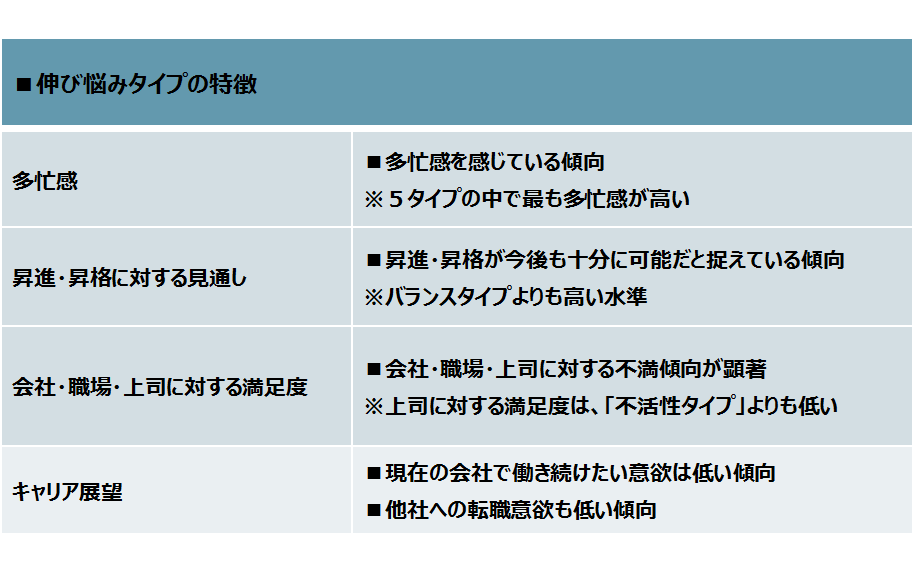
The results of the survey (see above) show that the “stagnant type” has an average or below average score for the five behavioral characteristics, and some people may associate this with the image of the so-called “older men who don’t work”, who feel bored during working hours and show no ambition to advance within the company. However, our survey results show a different picture of this type of person. Specifically, it was found that the “stagnant type” is characterized by working busier than other types and believing that future promotion and advancement are well within their grasp. Despite this, the “stagnant type” is also characterized by a marked tendency to be dissatisfied with their company, workplace and superiors.
The “stagnant type” is most common in the early 50s, and considering their current age, it is difficult to see them being promoted or given a higher position in the future. This result may reflect their dissatisfaction with the gap between their own positive outlook on promotion and advancement (their expectations for the future) and their current situation (their actual evaluation). Another interesting point is their outlook on their career.
If, as mentioned above, they are highly dissatisfied with their company, workplace and boss, it would seem that they would be highly motivated to change jobs to another company, but the results show that this is not the case. The results show that they are not actively motivated to work at their current company, but at the same time, they are not highly motivated to change jobs to another company either, and this “passive motivation to work” is a notable characteristic of this type.
Summary: Behavioral changes in the ‘stagnant type’ are the key to solving management issues
We conducted cluster analysis based on the five behavioral characteristics practiced by middle-aged and senior workers who are making rapid progress, and reported on the five types of human resources and their characteristics: “high-performing type”, “balanced type”, “stagnant type”, “noncommittal/comfortable type”, and “inactive type”. Of these, it was found that the “underachieving type” accounted for the largest proportion. In Japanese companies, where the average age of employees is now over 40 and the main workforce is shifting to middle-aged and senior workers, the performance of the “underachieving type”, which accounts for around 40% of the workforce, has a significant impact on the overall management of the company. In other words, it is no exaggeration to say that the pressing management issue is how to encourage the underachieving type to take action.
In the next report, we will look at how organizational and environmental factors (supervisor management, training and counseling, and workplace relationships) and individual factors (career awareness) affect the five behavioral characteristics that are important for improving the performance of “stagnant workers”.
(*1) The survey overview is as follows.
Survey Overview
Persol Research and Consulting / Hosei University Ishiyama Laboratory “Middle-aged and Senior Workers’ Advancement Survey” |
|
|---|---|
| Survey method | Internet survey using survey company monitors |
| Survey participants | 2,300 businesspeople who meet the following requirements (1) Men and women aged 40 to 69 who work for companies with 300 or more employees (2) Full-time employees (including those rehired after retirement in their 60s) |
| Survey period | May 12th to 14th, 2017 |
| Survey organization | Persol Research and Consulting / Ishiyama Laboratory, Hosei University |
Please clearly indicate the source when quoting.
Example of source: Persol Research and Consulting, Hosei
University Ishiyama Laboratory “Survey on the Actual Situation of Middle-aged and Senior Workers’ Advancement”
THEME
注目のテーマ
CONTACT US
お問い合わせ
こちらのフォームからお問い合わせいただけます